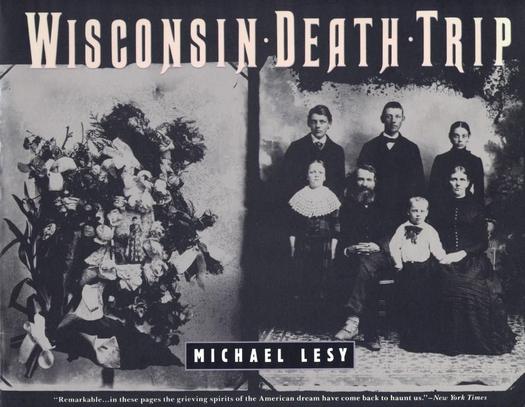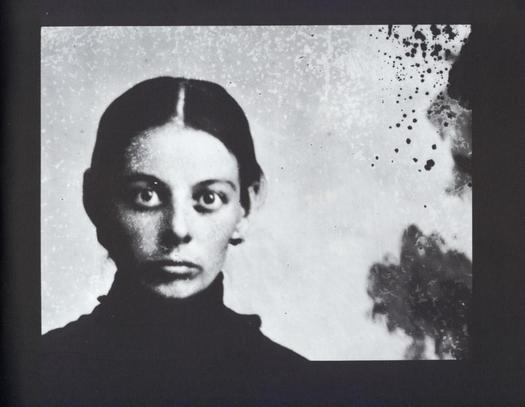
Wisconsin Death Trip, published by Anchor Books/Doubleday, 1991. Cover design by Mario J. Pulice
I can't remember where I first heard about Wisconsin Death Trip. It was probably in Susan Sontag's On Photography, where it is discussed briefly, but if that's the case then it was another 17 years before I finally saw it, in 1996, on a visit to the US. It was the kind of title — macabre, mythic, enigmatic and unsettling — that festered in the imagination. Michael Lesy's book appeared in 1973, when hair was still worn long and flairs flapped around the ankles, but the summer-of-love optimism of six years earlier had curdled and turned sour. "Trip" was a hippie drug term and its use suggested not so much a physical journey as a mind-blowing experience, whether good or bad — here, it was clearly bad. The hell's angel murder at the Altamont pop festival while the Stones were playing, the Manson gang's depraved blood-letting in Hollywood, and the redneck drive-by shooting at the end of Easy Rider could all be seen as death trips. A year after Wisconsin Death Trip came out, film director Tobe Hooper gave the long-hairs a grotesquely unpleasant time in The Texas Chainsaw Massacre.
Wisconsin Death Trip was reprinted as a paperback by Anchor Books/Doubleday in 1991 (the version shown above) and reissued by the University of New Mexico Press in 2000 — it is still in print. The book documents events in Black River Falls, Wisconsin between 1885 and 1900, using photographs taken by town photographer Charles Van Schaick, which survive as glass plate negatives, and dozens of excerpts from news reports in the Badger State Banner, as well as insane asylum records, literary quotations, and local gossip. The texts form a grim catalogue of arson, cruelty, dementia, suicide, murder, business failure, incest, premature burial, and regular outbreaks of diphtheria and smallpox. Women kill themselves over grief at the death of their children. Men kill themselves for lack of work. Horror piles upon horror. A brother and two sisters go insane within weeks of each other; a woman poisons her baby with strychnine; another slashes her stomach with a butcher knife; and a man blows his head off with a stick of dynamite. In separate incidents, two elderly women douse their bodies with kerosene and set themselves ablaze.

Wisconsin Death Trip, detail of a photograph by Charles Van Schaick
This was remarkable enough but what made the book extraordinary — and controversial — was the way it used photographs alongside the texts. Of the 30,000 images taken by Schaick, 3,000 survive. From these, Lesy selected about 140 that he judged to contain sufficient information. Some of the most affecting show dead infants in their coffins. Such photographs were commonplace then, but many viewers, including me, saw them here for the first time. Many of the pictures are single or group portraits taken in the photographer's studio; others show families in front of their properties and groups of people outside shops. Lesy, credited with sequencing and montage, intervenes in various ways. (The designer was Stevan A. Baron, later production director of Aperture.) Sometimes Lesy blows up a salient detail, as with the young woman with the haunting eyes shown above, who is photographed behind her mother in the family portrait used on the 1991 edition's cover. The negative's emulsion has decayed, causing dark speckles in the corner, like droplets of blood, as Lesy noted later. Lesy doubles images and constructs montages to repeat and intensify key parts of a picture: people's facial expressions or the positions of their hands. He also includes engravings of hats, a revolver, a doily, a corset, a railway locomotive. These date the book — countercultural designs of the period often made use of Max Ernst-like Victorian collages — but they colour its atmosphere and add to the sense that it is aiming for a heightened poetic understanding of the tragedies it records.
It was this that troubled some of the book's reviewers. Lesy spoke of constructing the text "as music is composed", using tone, pitch, rhythm and repetition. By treating images and excerpts in this way, he was attempting a new kind of "poetic history" or "psychic history" that uncovered interconnections and made tangible experiences that other kinds of history writing overlook. "Those who read the book couldn't decide whether it was poetry or history, a fabrication or a discourse, a hoax or a revelation," Lesy recalls in another book he wrote about death, The Forbidden Zone (1987). At the end of Wisconsin Death Trip, he suggests that his book reveals how harsh economic conditions produced high levels of obsessive-compulsive behaviour and paranoia among people exposed to unemployment and sudden death who were naturally fearful for themselves and their loved ones. By extension, the book might seem to be an attack on the capitalist underpinnings of present-day America. As Warren Susman notes in the original preface, Lesy shows us not the American Dream, but the American Nightmare.
With stakes this high, it is not surprising that some critics felt Lesy should have paid closer attention to socio-economic conditions in Black River Falls and provided more information about industrial failures and the depletion of farm land. How representative were the pictures he chose? Was it acceptable to modify and distort the work of a photographer in this way? Was Lesy guilty of selecting only evidence that reinforced his own point of view?
No doubt Wisconsin Death Trip does present problems when viewed from the strict methodological perspectives of historical study or journalism, but few would dispute its power when experienced as art, or as a kind of clairvoyant fiction-based-on-fact, a subjective remembrance and resurrection of actual events. A "death trip", in 1960s drug talk, was also a vision of death and a rebirth. Lesy's compositional methods did, in any case, have precedents, as Susman's preface makes clear. He notes that German writer and critic Walter Benjamin's ideal was to produce a work entirely out of quotations. (The final section of Sontag's On Photography, "A Brief Anthology of Quotations", is a homage to Benjamin.) Lesy extends this method to his picture material then inter-cuts the two kinds of information, allowing the reader to make intuitive connections and discover meanings by sliding between these layers. He said recently that he didn't intend readers to fixate on the book's horrors, though with the book's title what did he really expect? He also felt that people had tended to prioritise the text at the expense of the images and to that extent he thought the book had failed. His approach was nevertheless quite different from the conventional way of anchoring an image with a caption intended to direct and limit the reader's interpretation.
Lesy's first plan was to make a film out of the material. He didn't have the money so he did the book instead. British director James Marsh's film, released in 1999, has its strengths, but it lacks the book's concentration and darkness, its sense of lingering miasma, of having stumbled upon an open grave that history had forgotten to mark on the map. Marsh inserts photographs not used by Lesy to fill out the narrative and the film predictably resorts to dramatic reconstruction, using actors to play characters such as notorious window smasher Mary Sweeney and a teenage killer on the run. News reports that give only the bare bones become costumed, art directed, screen-worthy anecdotes. Where Lesy's book is the product of a particular era and says something about its own historical moment, the film version lacks the same feeling of necessity; and where the book stands out even today for refusing to be bound by the editorial and structural conventions of the medium, the film is ultimately just a classily made film. Thirty years on, still finding readers, still an overwhelming experience for those who enter its mysteries, Lesy's cult classic remains a spellbinding piece of literary and photographic alchemy.
